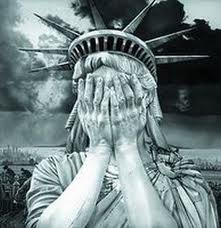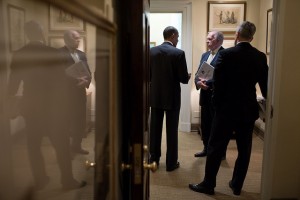We’re an empire now, and when we act, we create our own reality.
Partly by design, the debate about torture that has already started in advance of tomorrow’s Torture Report release is focused on efficacy, with efficacy defined as obtaining valuable intelligence. Torture apologists say torture provided intelligence that helped to find Osama bin Laden. Torture critics refute this, noting that any intelligence CIA got from those who were tortured either preceded or long post-dated the torture.
Even setting aside my belief that, even if torture “worked” to elicit valuable intelligence, it still wouldn’t justify it, there’s a big problem with pitching the debate in those terms.
As the Senate Armed Services Committee Report on torture (released over 5 years ago, in far less redacted form than tomorrow’s summary will be) makes clear, the Bush regime embraced torture not for “intelligence” but for “exploitation.” In December 2001, when DOD first started searching for what would become torture, it was explicitly looking for “exploitation.”
As Administration lawyers began to reconsider U.S. adherence to the Geneva Conventions, the DoD Office of the General Counsel also began seeking information on detention and interrogation. In December 2001, the DoD General Counsel’s office contacted the Joint Personnel Recovery Agency (JPRA), headquartered at Fort Belvoir, Virginia, for information about detainee “exploitation.
And as a footnote explaining that reference makes clear, “interrogation is only one part of the exploitation process.”

Some other things exploitation is used for — indeed the very things the torture we reverse-engineered for our own torture program was used for — are to help recruit double agents and to produce propaganda.
And we have every reason to believe those were among the things all incarnations of our torture were used for. We tortured in Abu Ghraib because we had no sources in the Iraqi resistance and for some reason we believed sexually humiliating men would shame them into turning narcs for the US.
Sami al-Hajj, the Al-Jazeera journalist held at Gitmo for 6 years, says the US wanted him to spy on ties between that outlet and al Qaeda for them.
SAMI AL-HAJJ: Yes, yes, three people, and one translator. And they told me, “Your story is clear. You don’t have anything. But you are now in Guantánamo, and we wait until we get some decisions from Pentagon to release you. Until that time, we want you to be patient and to cooperate with our people.” Later on, someone, he came, and they told me, “You are here to preparing you to cooperate with us in future.” I told him, “What that means?” He said, “You said in Kandahar you are ready to cooperate with us.” I told him, “Yes, I said that. But I said that I mean by ‘cooperate’ to answer question, not to work with you.” He said, “No, we understand you want to be with us, work with us.” And they starting give me some offer to give me a U.S.A. nationality and take care about my family, if I work with them in CIA to continue my job being journalist with Al Jazeera, just send for them some information about the link between Al Jazeera and al-Qaeda and the terrorist people and some people in the Middle East. Of course, I refused to do that. I told them, “I’m journalist, and I will die as a journalist. I will never work as a work, and just only journalist.”
And while I question whether we’ll ever learn the truth about Hassan Ghul, he reportedly agreed to infiltrate al Qaeda for us after we tortured him before he flipped back and got killed in a drone strike.
So one reason the CIA and DOD embraced torture was in hope of recruiting people to become our spies.
The propaganda value of torture, however, will receive far less attention still, because the implications of it are truly horrible. All reports about our torture assume that we “knew” the answers we wanted because we were stupid — we assumed al Qaeda had more plots than they did, or had grander plans than they did.
Or had ties with Iraq.
But when we consider the case of Ibn Sheikh al-Libi, whose torture-induced claim al Qaeda had ties to Iraq’s WMD programs helped drag us into Iraq,
According to al-Libi, the foreign government service [redacted] “stated that the next topic was al-Qa’ida’s connections with Iraq. … This was a subject about which he said he knew nothing and had difficulty even coming up with a story.” Al-Libi indicated that his interrogators did not like his responses and then “placed him in a small box approximately 50cm x 50cm.” He claimed he was held in the box for approximately 17 hours. When he was let out of the box, alLibi claims that he was given a last opportunity to “tell the truth.” When al-Libi did not satisfy the interrogator, al-Libi claimed that “he was knocked over with an arm thrust across his chest and he fell on his back.” Al-Libi told CIA debriefers that he then “was punched for 15 minutes.”216
(U) Al-Libi told debriefers that “after the beating,” he was again asked about the connection with Iraq and this time he came up with a story that three al-Qa’ida members went to Iraq to learn about nuclear weapons. Al-Libi said that he used the names of real individuals associated with al-Qa’ida so that he could remember the details of his fabricated story and make it more believable to the foreign intelligence service. Al-Libi noted that “this pleased his [foreign] interrogators, who directed that al-Libi be taken back to a big room, vice the 50 square centimeter box and given food.”217
And when you consider that Abd al-Rahim al-Nashiri claimed his torturers told him he had to claim Osama bin Laden had nukes,
>Number six. Usama bin Laden having a nuclear bomb. [REDACTED]. Then they used to laugh. Then they used to tell me you need to admit to those information. So I used to invent some of the stuff for them to say Usama bin laden had a, had a nuclear bomb. And they use to laugh and they were very happy. They were extremely happy because of the news. Then after that I told them, listen. He has no bomb.
When you consider under torture Abu Zubaydah turned Jose Padilla’s web searches into an active dirty bomb plot.
And when you consider that Dick Cheney wanted to have Iraqi Mukhabarat member Muhammed Khudayr al-Dulaymi waterboarded because he was sure he knew of the tie between Iraq and al Qaeda,
At the end of April 2003, not long after the fall of Baghdad, U.S. forces captured an Iraqi who Bush White House officials suspected might provide information of a relationship between al Qaeda and Saddam Hussein’s regime. Muhammed Khudayr al-Dulaymi was the head of the M-14 section of Mukhabarat, one of Saddam’s secret police organizations. His responsibilities included chemical weapons and contacts with terrorist groups.
[snip]
Duelfer says he heard from “some in Washington at very senior levels (not in the CIA),” who thought Khudayr’s interrogation had been “too gentle” and suggested another route, one that they believed has proven effective elsewhere. “They asked if enhanced measures, such as waterboarding, should be used,” Duelfer writes. “The executive authorities addressing those measures made clear that such techniques could legally be applied only to terrorism cases, and our debriefings were not as yet terrorism-related. The debriefings were just debriefings, even for this creature.”
Duelfer will not disclose who in Washington had proposed the use of waterboarding, saying only: “The language I can use is what has been cleared.” In fact, two senior U.S. intelligence officials at the time tell The Daily Beast that the suggestion to waterboard came from the Office of Vice President Cheney.
Then it raises the really horrible possibility that Cheney pushed torture because it would produce the stories he wanted told. It would be difficult to distinguish whether Cheney believed this stuff and therefore that’s what the torture produced or whether Cheney wanted these stories told and that’s what the torture produced.
As Steven Kleinman said in an important Jason Leopold and Jeff Kaye story on this subject, the torture CIA used was designed to get false confessions, not accurate information.
“This is the guidebook to getting false confessions, a system drawn specifically from the communist interrogation model that was used to generate propaganda rather than intelligence,” Kleinman said in an interview. “If your goal is to obtain useful and reliable information this is not the source book you should be using.”
The people who approved torture had the means of knowing — should have known — it would elicit false confessions. It’s just that no one can prove whether that was the entire point or not.
In this respect, then, the debate we’ll resume tomorrow is similar to the debate about the phone dragnet, where the government has not fully described the purposes it serves (indeed, in both cases, the government is hiding their use of the program to obtain spies).
It’s not just a question of whether torture is “effective” at obtaining intelligence. It’s also whether the entire point of it was to produce spies and propaganda.
 Okay, here are the critical working documents:
Okay, here are the critical working documents:

